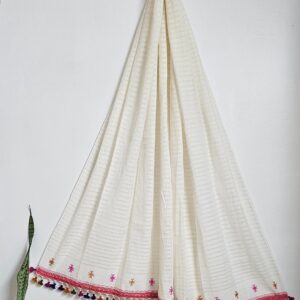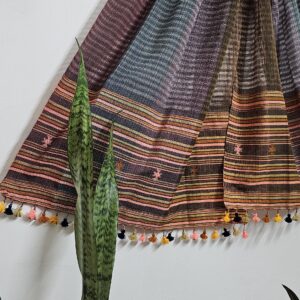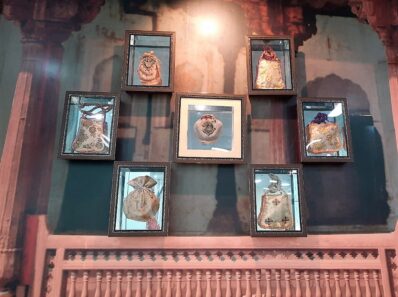Bhujodi is famous because of its ‘Kutchi’ shawls that received the ‘GI (Geographical Indication) tag’ and is recognised all over the world. More than 70 weavers of this village have won International, national and state awards.
Bhujodi is a small town, located 8 km southeast of Bhuj taluka in Kutch district of Gujarat. Bhujodi has a population of around 5000 people in 400 houses. 80% of the village is involved in traditional weaving of textiles. There are three main communities in Kutch, Vankar,Rabari and Ahir. Each community has its area of work well defined and prefers to stick to its own profession.
Vankars are the ones who weave all types of textiles like shawls, stoles, fabric, sarees, dupattas, suits and more. They preserve the traditional weaving techniques with the use of soft cotton yarn, wool and rain fed cotton as weaving is an important part of Kutch cultural heritage.
Ahir community is the one responsible for farming in the region. They are also cow herders. Women in the community spend their spare time indulging in special embroidery called-Ahir. Ahir embroidery is done intricately with the use of mirrors and vivid colors, adorned on to their own costumes. It has special significance during weddings and other celebrations.
Rabari community is a nomadic tribe involved in their traditional camel herding, raising goats and sheep. They provide the yarn to vankars that is required for weaving. Rabari embroidery is famous for its intricate designs inspired by history, surrounding and its culture.
Kachh has harsh weather. In winters it ranges from 10 to 28 degree whereas in summer and rainy season it ranges from 25 to 50 degree.
During winters, Rabari community that were on the move needed warm clothing to bear the harsh winters. The ‘Vankars’ slowly developed shawls and designs that suited the requirements of the ‘Rabari’ community, and so the designs became characteristic of this community. The Rabaris preferred black and white undyed yarn fabric. Ahir also needed warm clothing that was provided by Vankars. Ahir went for brighter hues. This helped in distinguishing the work of communities separately, even though they worked independently as the craft grew.
A popular belief says that 500 years ago the daughter of a rich ‘Rabari’ family came to Kutch after her marriage. A weaver was sent along with her as part of her dowry, so that he could weave whatever she desired. The family of this weaver grew into a large community over time and they came to be known as the craftsmen of Kutch. Now Bhujodi has transformed into Gujarat’s eminent textile center.
Weaving Process-
Weaving is done on a handloom called Pit Loom. It has a pit below the loom where the weaver sits and operates the loom manually with four pedals. Pit loom can produce more fabric. It can absorb the moisture in yarn and produces better weaving results.
Motifs- Motifs used in Bhujodi weave are inspired by nature, local culture, stories, architecture such as forts, monuments such as Rani ki vav and so on.
Some of the motifs are Meeri, Jhar and phool, Chaumukh, Panchka, Sathkhani, Dhumla (Damru like design), wankia and so on.Each motif has its own origin and significance.
Yarn- In earlier days, the most popular yarn was wool. Wool was used to weave warm shawls to survive the harsh winters. This is weaved by dipping the yarn in lukewarm wheat paste as the yarn is very brittle. After it is sun dried, it is cleaned. Yarn is then moved to a wooden instrument called chaukhta which turns it into the warp and a bobbin is used to prepare the weft. Traditionally natural dyes are used on cotton, woollen fabrics. Now also the same process is followed to weave kala cotton yarn as it gives strength to the fabric.
Weaving is a time consuming process. Depending on the design It takes one day to several months to weave one Bhujodi shawl, stoll. As described by the weaver, it takes great patience, peacefulness within and a good heart to weave these products which are later adorned with handmade embroidery laces, latkans made by women in the household.
Bhujodi products, particularly handwoven textiles, have good demand in the international market due to their unique craftsmanship, cultural significance, and increasing appreciation for sustainable, handcrafted goods. Lets celebrate this summer with our own Made In India soft cotton Bhujodi stoles, weaved with loads of hardwork and love by our weavers. Let us include them in our lifestyle by shopping for these beautiful handcrafted Stoles at www.parimalecohub.com .
Sample Product Collections
-
Cream Color Kutch Bhujodi Weave Handloom Cotton Stole
Original price was: ₹1,573.95.₹997.50Current price is: ₹997.50. -
Multicolor Kutch Bhujodi Weave Handloom Cotton Stole
Original price was: ₹1,573.95.₹997.50Current price is: ₹997.50. -
Bhujodi Kala Cotton Multicolor Handloom Saree with handcrafted embroidery designs
Original price was: ₹12,980.00.₹7,786.82Current price is: ₹7,786.82.
Check out our Bhojodi Stoles collection here.
Wish to explore more and customize your clothing range in Bhujodi craft, please click here and we will be ever ready to serve you.
In videos posted here you can see the weaving process as well as how the bobbins are made. In the next article we will elaborate on the intricate weaving process and village life of our weavers.
Thanks for investing your time on my blog. Please look at the below videos to understand craft in detail.
Let us appreciate and encourage these weavers who are struggling hard to keep the legacy of Bhujodi craft alive.
Watch out this space for more updates on Bhujodi…..







Really nice to see such intricate details from my place…Thanks for highlighting work done by our community..
Thank You for recognizing efforts. It is Parimal EcoHub’s continuous endeavour to encourage and support our weaver community. They are pride of our country.